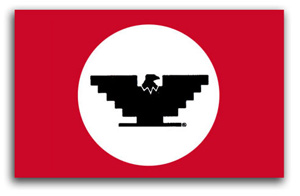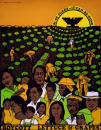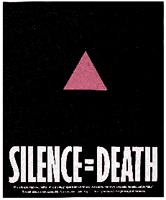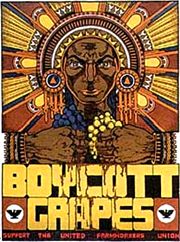org
United Farm Workers Logo

From Just Another Poster? Chicano Graphic Art in California:
In 1962, Cesar Chávez and his cousin Manuel conceived of the U.F.W. logo as a way to ‘get some color into the movement, to give people something they could identify with.’ they chose the Aztec eagle on the Mexican flag as the logo’s main symbol and created a stylized version of it that was easy to reproduce. The U.F.W. logo became a highly recognizable icon in the union’s boycott efforts, legislative, proposition campaigns, and a victorious symbol of its successful contract negotiations.
The symbol and flag were unveiled at the first mass meeting of the newly formed union.
From Aztlannet:
 The evolution of Chicano poster art began in 1965 with the production of graphic images to support the organizing and boycotting efforts of the United Farm Workers. The U.F.W. logo — a black stylized eagle with wings shaped like an inverted Aztec pyramid — became a key symbol of the Chicano movement. It appeared prominently on all official U.F.W. graphics, and its inclusion on unrelated posters made by Chicano artists signaled support for the union. Posters also were utilized to promote other Chicano political causes, such as the 1968 Coors beer boycott in protest of the company’s discriminatory hiring practices.
The evolution of Chicano poster art began in 1965 with the production of graphic images to support the organizing and boycotting efforts of the United Farm Workers. The U.F.W. logo — a black stylized eagle with wings shaped like an inverted Aztec pyramid — became a key symbol of the Chicano movement. It appeared prominently on all official U.F.W. graphics, and its inclusion on unrelated posters made by Chicano artists signaled support for the union. Posters also were utilized to promote other Chicano political causes, such as the 1968 Coors beer boycott in protest of the company’s discriminatory hiring practices.
Call for Submissions: Sappi Ideas The Matter
“Ideas that Matter is an initiative by [paper company] Sappi that provides funding to support creative design for social good. Your talent and skills could benefit the many institutions working for change: non-profit organisations that are involved in scientific, environmental, educational, cultural or relief programmes.
Sappi is ready to award financial grants of up to €50,000 to pay your out-of-pocket expenses and the full implementation of a print campaign. This includes the cost of the photography, illustration, films, paper, printing, mailing, etc...
Select the non-profit organisation that would benefit from your ideas and ask them to agree to your ideas and application for a grant. Then prepare your creative print campaign proposal and submit it to Sappi. Remember your campaign must exploit the effectiveness of ideas on paper, maximising the potential of posters, direct mail, brochures or print advertising - or something new. Of course, you can submit more than one application if you have more than one idea.”
Check some of the previous winners. The org seems inclined (though not necessarily limited) to funding projects that promote charities that promote children’s rights and humanitarian health and development projects. Get your application here. Entries must be postmarked by May 31, 2003.
When picking a paper stock, you might also consider some of their fine woodfree products.
Call for Submissions: Prison Families Community Forum
Prison Families Community Forum Launches Campaign to Fight Inmate Telecom Injustices In New York State
 The Prison Families Community Forum needs visual art work! Prison Families Community Forum is a growing network of families directly affected by incarceration in New York State. We are part of a Brooklyn-based non-profit community development organization and are mobilizing families of NYS prisoners to fight the exploitative and dehumanizing practices of New York State, the Department of Corrections and MCI. To keep in contact with loved ones inside, families are forced to absorb charges up to 68% more than anyone else in NYS pays for a collect phone call, a kickback to the state.
The Prison Families Community Forum needs visual art work! Prison Families Community Forum is a growing network of families directly affected by incarceration in New York State. We are part of a Brooklyn-based non-profit community development organization and are mobilizing families of NYS prisoners to fight the exploitative and dehumanizing practices of New York State, the Department of Corrections and MCI. To keep in contact with loved ones inside, families are forced to absorb charges up to 68% more than anyone else in NYS pays for a collect phone call, a kickback to the state.
We are looking for intense, compelling and even graphic visuals that speak to the hardships faced by families and communities of the incarcerated. Your work will be used for public education, direct action campaign materials, and other forms of print and electronic media, and will help our families more effectively communicate our calls for justice.
Please call for specific details on images which would be most useful. Any visuals representing the injustices of prison are welcome. Artwork may be submitted as JPEGs, prints, or slides and may be sent via email as an attached file and/or via snail mail to the address below.
Please submit art to:
Kym Clark
Criminal Justice Organizer
Developing Justice
c/o Fifth Avenue Committee
141 Fifth Avenue
Brooklyn, NY 11217
718/857 -2990 x41
kclark -at- fifthave -dot- org
SILENCE = DEATH
 From the Encyclopedia of AIDS:
From the Encyclopedia of AIDS:
“The pink triangle was established as a pro-gay symbol by activists in the United States during the 1970s. Its precedent lay in World War II, when known homosexuals in Nazi concentration camps were forced to wear inverted pink triangle badges as identifiers, much in the same manner that Jews were forced to wear the yellow Star of David. Wearers of the pink triangle were considered at the bottom of the camp social system and subjected to particularly harsh maltreatment and degradation. Thus, the appropriation of the symbol of the pink triangle, usually turned upright rather than inverted, was a conscious attempt to transform a symbol of humiliation into one of solidarity and resistance. By the outset of the AIDS epidemic, it was well-entrenched as a symbol of gay pride and liberation.
In 1987, six gay activists in New York formed the Silence = Death Project and began plastering posters around the city featuring a pink triangle on a black background stating simply ‘SILENCE = DEATH.’ In its manifesto, the Silence = Death Project drew parallels between the Nazi period and the AIDS crisis, declaring that ‘silence about the oppression and annihilation of gay people, then and now, must be broken as a matter of our survival.’ The slogan thus protested both taboos around discussion of safer sex and the unwillingness of some to resist societal injustice and governmental indifference. The six men who created the project later joined the protest group ACT UP and offered the logo to the group, with which it remains closely identified.
Since its introduction, the ‘SILENCE = DEATH’ logo has appeared in a variety of manifestations, including in neon as part of an art display and on a widely worn button. It was also the forerunner of a range of parallel slogans such as ‘ACTION = LIFE’ and ‘IGNORANCE = FEAR’ and an entire genre of protest graphics, most notably including a bloodstained hand on a poster proclaiming that ‘the government has blood on its hands.’ Owing in part to its increasing identification with AIDS, the pink triangle was supplanted in the early 1990s by the rainbow as the dominant image of ‘gay pride.’ By force of analogy, however, the rainbow itself has, in some countries, become an image associated with AIDS.”
via ACT UP NY:
“There was also the SILENCE=DEATH Project, which was a group of men who had started meeting a year and half before [ACT UP was started], including Avram Finklestein, Oliver Smith, and Chris Lione. They were a whole group of men who needed to talk to each other and others about what the fuck were they going to do, being gay men in the age of AIDS?! Several of them were designers of various sorts—graphic designers—and they ended up deciding that they had to start doing wheat-pasting on the streets, to get the message out to people: ‘Why aren’t you doing something?’ So they created the SILENCE=DEATH logo well before ACT UP ever existed, and they made posters before ACT UP ever existed, and the posters at the bottom said something like, ‘What’s really happening in Washington? What’s happening with Reagan and Bush and the Food and Drug Administration?’ It ended with this statement: ‘Turn anger, fear, grief into action.’ Several of these graphic designers were at that first evening that Larry spoke.”
Big ’up to v-2.
Gráficos y El Movimiento
From poster designer Mark Vallen:
 Just Another Poster? Chicano Graphic Arts in California, is the first exhibition and book that explores the Poster Art created by dozens of Chicano Artists in California from the late 1960’s to the present... Graphic art has played a key role in El Movimiento (the Chicano Civil Rights movement), and the poster has been used to educate, agitate, and organize Americans of Mexican descent...
Just Another Poster? Chicano Graphic Arts in California, is the first exhibition and book that explores the Poster Art created by dozens of Chicano Artists in California from the late 1960’s to the present... Graphic art has played a key role in El Movimiento (the Chicano Civil Rights movement), and the poster has been used to educate, agitate, and organize Americans of Mexican descent...
The posters frequently use Mexican icons reworked to express a unique Chicano perspective.
Chicano Poster Art became a means to help preserve and promote a culture largely ignored by the dominant Eurocentric society of the United States. Artists glorified Aztec Gods, Mexican Revolutionaries, the Virgin de Guadalupe, Immigrant Farm Workers, and the experiences of everyday Raza (people)...
Most of the work in the exhibit was produced in association with one of six major Chicano art centers and cooperatives: Royal Chicano Air Force (Sacramento), Galería de la Raza (San Francisco) and La Raza Silkscreen Center/La Raza Graphics (San Francisco), Self-Help Graphics and Art (Los Angeles) and the Mechicano Art Center (Los Angeles), and Centro Cultural de la Raza (San Diego). All but the Galería de La Raza were centers of poster production.
Boycott grapes poster by Xavier Viramontes, 1973, offset lithograph, printed by striking farm workers.
Donate Your Cell Phone
Upgrading to a new cell phone? Don’t throw out your old one! If you live in the U.S., send it to Call to Protect.
“Call to Protect is a national wireless phone collection drive designed to provide domestic violence victims and organizations with one of the most powerful tools in the fight against domestic violence... a wireless phone. The program is a partnership between the Wireless Foundation, the National Coalition Against Domestic Violence and Motorola who have worked together since 1996 to provide free phones to victims of domestic violence through the program.”
Free emergency airtime is donated by wireless service providers. Check the FAQ.
Design for Democracy
Misleading ads, voter intimidation, malfunctioning and confusing ballots... problems continue to plague U.S. elections. And designers are starting to step up.
Design for Democracy is an non-profit organization in Illinois . It’s mission is to:
“Improve the informational and physical systems involved in the American voting experience through education and user-centered research, evaluation, strategic design, and implementation, in order to support an environment in which every voter counts.”
 From the about page:
From the about page:
“The team is national. Our focus is local. We approach election issues with a unique perspective: as designers. To do that we have specialists in graphic design, industrial design, interface design, Web site development, anthropology, and usability, all of whom understand the human factors in the voting.
We are objective and independent, and we are valued for our ability to consider all possible solutions without preference to a particular technology, ideology or organization. Our commitment is to the public good and we adhere to standards and practices that preserve our client-focused point of view. Our recommendations and the materials we create will be based on meeting election code requirements and understanding what will be easily implementable by those who operate elections.
Design for Democracy... is not aligned or associated with any corporations, organizations or entities that advocate a specific voting product or service.
Design for Democracy works directly with election officials in both large and small jurisdictions to maximize their resources and achieve specific goals.
For large jurisdictions, we can comprehensively study singular issues and determine areas for improvement in processes, procedures and materials. Then we can apply our knowledge and experience to recommend and implement those improvements.
With smaller jurisdictions, we can apply proven strategies and solutions, including templates that can be easily adapted to a particular need. These templates have already been used successfully in two Cook County, Illinois elections.”
Affiliated organizations include the Industrial Designers Society of America, the American Institute of Graphic Artists, the Usability Professionals Association, and the University of Illinois at Chicago.
Thus far they’re primarily active in Chicago, with a project in Oregon. After a proposed redesign of Chicago’s butterfly ballot, the group then worked to change the Illinois Election Code to implement the redesign and legally allow the use of lowercase letters in candidate names. Student projects include the design of a more universally accessible voting booth and a more efficient document handling system.
Also, the nod to “user-centered research” in the mission statement refers mainly to field research and documentation rather than actual participation by voters and poll workers in the design process. At minimum, the usability professionals should be able to incorporate user feedback and testing into the process rather than just at the initial data gathering phase.
Once the voting process is redesigned, a hard look at how design can facilitate public participation in other processes (such as candidate making, ballot initiatives, campaign financing, city planning, etc.) would be much welcome.
Otherwise, this seems like a good first step towards engaging designers in civic affairs.
A follow up to this brief blog item on ballot design from May 2002.
Center for the Study of Political Graphics
“There has never been a movement for social change without the arts — theatre poetry, music posters — being central to that movement. Political posters in particular are powerful living reminders of struggles worldwide for peace and justice. Communication, exhortation, persuasion, instruction, celebration warning: graphic art broadcasts its humanity through bold messages and striking iconography.
The Center for the Study of Political Graphics (CSPG) is a nonprofit, tax-exempt educational archive that collects, preserves, documents, and exhibits domestic and international posters relating to historical and contemporary movements for peace and social justice....
The archive includes more than 35,000 posters produced in a staggering array of visual styles and printing media, dating from the Russian Revolution to the present. University, museum, and public collections of this material are rare, and because those that do exist are seldom accessible to the public, CSPG’s commitment to continually exhibiting this rich visual and social history is so critical....
The Center was recently awarded a major grant from the Getty Grant Program to implenient a state-of-the-art electronic cataloging system designed to make the collection even more accessible.”
I do hope “more accessible” includes publishing more of their collection online. On the CPSG site, the exhibit Presidential Rogues Gallery: Satrical Posters 1960 - Present features a mere 11 images. The Sixties Project has published another of the CPSG’s exhibits online. Decade of Protest: Political Posters from the United States, Cuba and Viet Nam 1965-1975 features 67 posters that were shown at the Track 16 Gallery in Santa Monica in 1996.
Though the center limits its collection to posters from peace and justice movements, a thorough study of propaganda technique would also include material from a right-wing point of view. Movements for peace and justice would also do well not to ignore grassroots conservative movements, their history and political graphics.
The image above is copyright 1971 by the Committee to Help Unsell the War, “a coalition of over 30 advertising agencies.”
Collective Agency
“iStockPhoto is a collection of royalty-free files contributed by its members. iStock members are part of an international community of artists which has created a huge database, growing at an exponential rate. Members can download from a collection of images, audio, and Flash, browse through our forums on design and photograph.
Members can now download from a database of hi-rez images, audio, Flash and more for [U.S.] 25 cents per download - new members start with 2 download credits to get accquainted.
Download credits are accumulated either by depositing money into your iStock account or from download earnings. iStock uses $.20 from each download to cover its bandwidth costs, and $.05 (five cents) is returned to the member who uploaded the file. This ensures that regular contributors will always have download credits, and all others can download photos for only $.25 each.”
Most stock photography is out of the financial reach of individuals and organizations without a photo budget. Photodisc, the pioneer of the online stock photo market, charges $50 a pop for its cheapest images. iStockPhoto is a kind of mutual-support initiative providing imagery to its members practically for free.
And, through iStockPhoto the photographer, not the photo agency, retains the copyright of the images. Many stock photo agencies have increasly asked photographers to give away more and more of their rights for less and less money.
Unfortunately, for photographers who depend on income from their imagemaking this grassroots initiative is yet another contender in a crowded market. But for those who believe imagery should be free and who want to share it freely iStockPhoto is a beautiful thing.
Media Democracy Day
October 2002 is October 18, 2002 is Media Democracy Day, “a day of education, protest, and calls for change in the interest of the people.”
Media Democracy Day pushes for and promotes a mass media system that informs and empowers all members of society. Media Democracy Day connects existing critical and creative media with active social movements, creating a coherent message for public attention and local and global action.
Following the rise of social movements for feminism, racial justice, and environmentalism in recent decades, international efforts to democratize the media are now mobilizing for education, protest, and change. Media Democracy prioritizes diversity over monotony, citizen control over corporate choice, cultural development over company profit, and public discourse over public relations.
Visit the Web sites in the U.S. and U.K.. Events are planned around the world. This flyer lists some in the U.S., Canada, and Europe.


